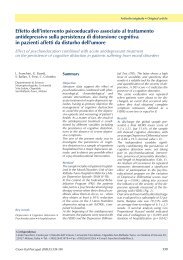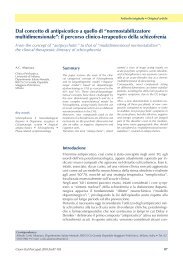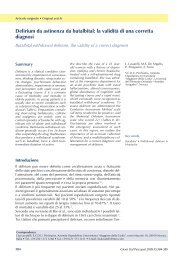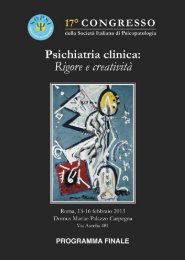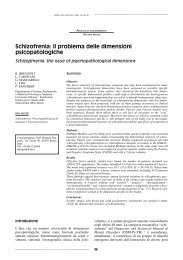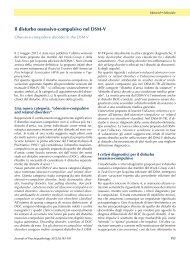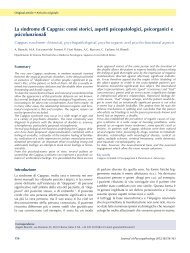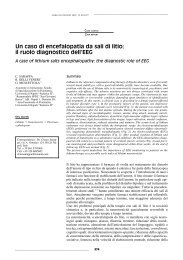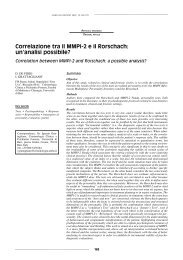XI Congresso della Società Italiana di Psicopatologia Psichiatria ...
XI Congresso della Società Italiana di Psicopatologia Psichiatria ...
XI Congresso della Società Italiana di Psicopatologia Psichiatria ...
You also want an ePaper? Increase the reach of your titles
YUMPU automatically turns print PDFs into web optimized ePapers that Google loves.
maco psicotropo, e 10 pazienti affetti da <strong>di</strong>versi <strong>di</strong>sturbi<br />
psichiatrici caratterizzati da sintomi psicotici. A tutti i soggetti<br />
<strong>di</strong>giuni sono stati prelevati 25 ml <strong>di</strong> sangue venoso dal<br />
quale è stato separato il plasma ricco <strong>di</strong> piastrine (PRP). Il<br />
PRP è stato successivamente <strong>di</strong>luito con tampone opportuno<br />
in modo da ottenere un numero fisso <strong>di</strong> piastrine/tubo su<br />
cui effettuare il dosaggio <strong>di</strong> uptake.<br />
L’uptake è stato effettuato incubando aliquote <strong>di</strong> sospensione<br />
cellulare (10 6 piastrine) con concentrazioni crescenti <strong>di</strong><br />
3 H-5-HT (range: 40 nM-1200 nM) e fatto procedere per 10<br />
min a 37°C. Per ciascuna concentrazione <strong>di</strong> 3 H-5-HT l’uptake<br />
non specifico è stato misurato me<strong>di</strong>ante l’aggiunta <strong>di</strong><br />
fluoxetina 10 mM non marcata.<br />
Risultati. Le Vmax e le Km dei soggetti sani erano rispettivamente<br />
(me<strong>di</strong>a ± D.S.): 133 ± 15 e 211 ± 67 mentre le<br />
Vmax e le Km dei pazienti psicotici erano (me<strong>di</strong>a ± D.S.):<br />
52 ± 18 e 161 ± 62 rispettivamente.<br />
Conclusioni. La Vmax dei pazienti è risultata significativamente<br />
più bassa rispetto ai controlli (p < 0,01), mentre non<br />
sono state evidenziate <strong>di</strong>fferenze significative per quanto riguarda<br />
le Km. Ciò riflette in parte la riduzione precedentemente<br />
evidenziata del numero <strong>di</strong> proteine che trasportano la<br />
5-HT, ma potrebbe essere dovuto anche a fenomeni <strong>di</strong> fosforilazione<br />
del trasportatore <strong>della</strong> serotonina da parte <strong>di</strong><br />
proteine chinasi, in particolare <strong>della</strong> proteina chinasi C<br />
(PKC), la cui attività potrebbe essere aumentata nei pazienti<br />
affetti da <strong>di</strong>sturbi psicotici.<br />
14. Serum magnesium levels in double<strong>di</strong>agnosis<br />
patients<br />
POSTER<br />
A. Barra, L. Monti, S. Daini, F. Tonioni, D. Martinelli,<br />
P. Bria<br />
Istituto <strong>di</strong> <strong>Psichiatria</strong>, Università “Cattolica del Sacro Cuore”<br />
<strong>di</strong> Roma<br />
Introduction: serum magnesium levels in psychiatric <strong>di</strong>sorders<br />
have been stu<strong>di</strong>ed because of magnesium role in neurotransmission.<br />
Higher Mg+ levels were found in mood <strong>di</strong>sorders,<br />
while low magnesium levels could be a marker of<br />
schizophrenia and autism. To date, no information is available<br />
about serum magnesium levels in double-<strong>di</strong>agnosis<br />
(drug dependency and psychiatric <strong>di</strong>sorders), even if psychiatric<br />
comorbi<strong>di</strong>ty is known to produce several metabolic<br />
<strong>di</strong>fferences in drug dependent subjects.<br />
Methods: our group evaluated serum magnesium levels in<br />
162 opiates ad<strong>di</strong>cts, recruited in our Day Hospital. 78 patients<br />
(48%) were affected with a comorbid personality <strong>di</strong>sorder,<br />
38 patients (23%) with a mood <strong>di</strong>sorder, 14 patients<br />
(9%) with an anxiety <strong>di</strong>sorder, and 32 patients (20%) were<br />
affected only with a substance abuse <strong>di</strong>sorder.<br />
Results: Our data revealed that opiates ad<strong>di</strong>cts with a comorbid<br />
personality <strong>di</strong>sorder (especially borderline and antisocial)<br />
showed serum Mg+ levels lower than those found in<br />
opiates ad<strong>di</strong>cts with an anxiety <strong>di</strong>sorder and without any comorbid<br />
psychiatric <strong>di</strong>sorder.<br />
Conclusions: accor<strong>di</strong>ng to previous fin<strong>di</strong>ngs, Mg+ serum<br />
levels were higher in patients with a comorbid mood <strong>di</strong>sorder<br />
with respect to the other cases.<br />
Further analyses are needed in order to enlighten the effects<br />
of psychiatric comorbi<strong>di</strong>ty on serum magnesium levels in<br />
heroin ad<strong>di</strong>cts.<br />
15. Au<strong>di</strong>ologic pathologies and psychiatric<br />
<strong>di</strong>sorders<br />
A. Barra, L. Monti, S. Daini, F. Tonioni, D. Martinelli,<br />
P. Bria<br />
Istituto <strong>di</strong> <strong>Psichiatria</strong>, Università “Cattolica del Sacro Cuore”<br />
<strong>di</strong> Roma<br />
Introduction: hearing loss can have considerable repercussions<br />
on the organization of the personality itself and on he<br />
basics attitude of the subject and can produce fragility in the<br />
relations with the external world and in the feelings about<br />
self. It was observed that in subjects who suffer from late<br />
onset paranoid psychoses it is common to find severe deafness.<br />
Au<strong>di</strong>tory hallucinations are reported in literature in<br />
central and peripheral au<strong>di</strong>ologic pathologies and often regret<br />
after an appropriate treatment. In particular there are reports<br />
of au<strong>di</strong>tory hallucinations and psychotic syndromes<br />
appeared in otosclerotic patients before stapes surgery with<br />
sequent remission, and appeared only after stape surgery.<br />
Methods: a multi<strong>di</strong>sciplinary study is ongoing in our University<br />
on 20 patients affected with otosclersosis, 20 patients<br />
affected with chronic middle ear otitis and 20 randomly<br />
taken subjects, all from 30 to 50 years of age, in order<br />
to define the possible psychiatric sides of these patients.<br />
Results: our analysis will be performed by means of: assessment<br />
of coping strategies and psychopathological and<br />
personality features (MMPI and EPI).<br />
16. La valutazione dell’insight <strong>di</strong> malattia<br />
nello spettro ossessivo-compulsivo<br />
T. Bassi, C. Rocco Di Torrepadula, S. Erzegovesi, P. Cave<strong>di</strong>ni,<br />
L. Bello<strong>di</strong><br />
Istituto Scientifico “San Raffaele”, Dipartimento <strong>di</strong> Scienze<br />
Neuropsichiche, Università “Vita-Salute San Raffaele”, Facoltà<br />
<strong>di</strong> Psicologia, Milano<br />
Introduzione: in questo stu<strong>di</strong>o si è voluto valutare quali<br />
<strong>di</strong>fferenze vi siano riguardo un fenomeno psicopatologico<br />
complesso e multi<strong>di</strong>mensionale quale l’insight <strong>di</strong> malattia<br />
tra soggetti con Disturbo Ossessivo Compulsivo (DOC) e<br />
soggetti con Disturbi <strong>della</strong> Condotta Alimentare (DCA)<br />
nonché tra soggetti con <strong>di</strong>fferenti DCA.<br />
Metodologia: il campione in esame è composto da 106 soggetti<br />
<strong>di</strong> cui 48 affetti da DCA, 35 affetti da DOC e 23 casi<br />
comorbi<strong>di</strong> (DOC + DCA). Il gruppo dei pazienti affetti da<br />
DCA risulta ulteriormente <strong>di</strong>viso in due sottogruppi <strong>di</strong> 36<br />
pazienti anoressiche e 28 pazienti bulimiche.<br />
A tutti i pazienti arruolati è stata somministrata la Brown Assessment<br />
of Beliefs Scale, un’intervista semistrutturata a 7<br />
items formulata da Eisen e Phillips nel 1993 per la valutazione<br />
dell’insight <strong>di</strong> malattia.<br />
Risultati: <strong>di</strong>fferenze significative emergono su specifiche<br />
<strong>di</strong>mensioni e sulla gravità totale dell’insight <strong>di</strong> malattia. I<br />
soggetti con DCA sono caratterizzati da un insight più scarso<br />
rispetto i soggetti con DOC e nei casi comorbi<strong>di</strong> la presenza<br />
del DCA tende a peggiorare l’insight anche sui contenuti<br />
non alimentari. Infine, poiché non emergono <strong>di</strong>fferenze<br />
tra i sottotipi <strong>di</strong> DCA (Anoressia e Bulimia Nervosa), per<br />
quanto concerne la <strong>di</strong>mensione psicopatologica dell’insight,<br />
si conferma l’ipotesi <strong>di</strong> un continuum anoressico-bulimico.<br />
234




